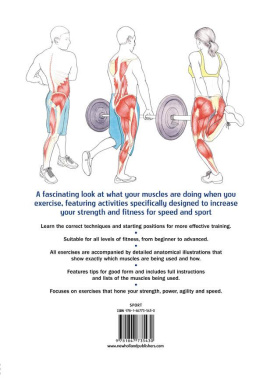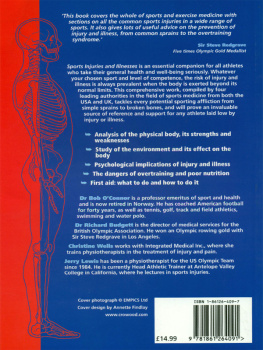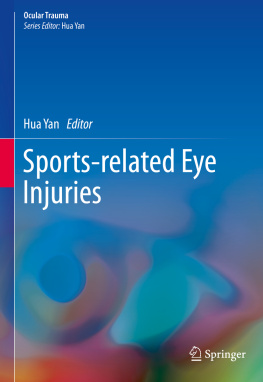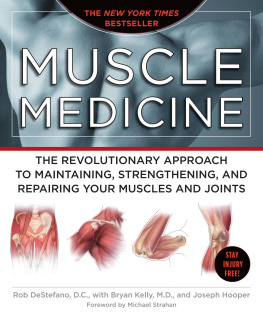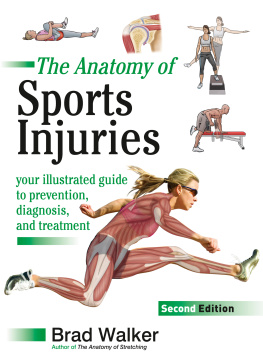PART 1 OVERVIEW OF
ANATOMY AND INJURIES
HOW TO USE THIS BOOK
Anatomy of Sports Injuries for Fitness and Rehabilitation is a visual and textual analysis of common sports injuries and rehabilitation of those injuries through effective exercises. It is also a guide to how to do the exercises properly and when to seek professional help to overcome your sports injury.
The book has three distinct parts: the first is a basic introduction to anatomical definitions, terminology and an overview of sports injuries. It also includes guidelines on injury prevention, acute care and first aid, manual therapy, long-term rehabilitation and lifestyle considerations.
Part two is divided into 13 sections covering a region of the body and highlights some of the most common injuries for that region. Each section defines individual injuries and their potential causes, treatment plans and statistics. Up to three mobilizations, stretches and/or exercises that may be used to help rehabilitate the injury are suggested as part of the corrective exercise programme following the acute phase of the injury.
Note that an injury can have many different causes and should be assessed by a trained professional to find the underlying causes. Any muscle imbalances should be highlighted at this stage and proper corrective stretching and strengthening should be given based on this information.
Disclaimer: Many of the exercises have a degree of risk of injury if done without adequate instruction and supervision. We recommend that you have a thorough assessment with a CHEK Practitioner, physiotherapist, osteopath or chiropractor before undertaking any of the exercises, and that you seek qualified instruction if you are a complete beginner. This book does not constitute medical advice and the author and publisher cannot be held liable for any loss, injury or inconvenience sustained by anyone using this book or the information contained in it.
Without a thorough assessment, the likelihood of full rehabilitation is greatly reduced, therefore, the stretches and exercises recommended may not be applicable to all.
Part three is an exercise section a how-to guide to doing the exercises as well as a visual and technical exercise analysis describing which muscles are being used. The start and finish position are usually depicted and training tips may be included.
The adult human body has more than 600 muscles and 206 bones; in this bookemphasis is placed on about 92 muscles involved in movement and stabilization. Many of the smaller muscles, as well the deep, small muscles of the spine and muscles of the hands and feet are not given specific attention.
This book is designed to help you improve your understanding of sports injuries and to overcome them and get back to performing at your best without the worry of further or future injury. Before starting a rehabilitation programme, the reader is advised to fully understand what phase of recovery they are in and introduce the right treatments and exercises at the right time (explained in part one). For instance, if stretches and exercises are used in the acute phase, this may further damage tissues and make the injury worse. Therefore, it is advised that you work through the book in the order it was written. In Part one, you will understand the anatomical definitions and terminology used in the book as well as a basic understanding of injuries and rehabilitation strategies. In Part two you will learn about your injury, while in Part three you will learn how to perform the exercises and stretches.
Ultimately, the injured tissues need to be conditioned to take the rigours of your sport in all planes of motion. This is known as end-stage rehab. While it is beyond the scope of this book to teach you end-stage rehab, the reader is advised to receive professional advice on strength and conditioning or read Anatomy of Strength and Fitness Training for Speed and Sport by Leigh Brandon.

ANATOMICAL DEFINITIONS AND TERMINOLOGY
Anatomy has its own language and although technical, it is quite logical, originating from Latin and Greek root words that make it easier to learn and understand the names of muscles, bones and other anatomy parts.
Whether you are an athlete, a student, a physio-therapist, a strength and conditioning coach or a CHEK practitioner, using the correct words and terminology enables you to interact with other professionals and professional materials.
Like most medical terms, anatomical terms are made up of small word parts, known as combining forms that fit together to make the full term. These combining forms comprise roots, prefixes and suffixes. Knowing the different word parts allows you to unravel the word. Most anatomical terms only contain two parts: either a prefix and root or a root and suffix.
For example, if you take the terms subscapular and suprascapular; the root is scapula, more commonly known as the shoulder blade. Supra means above, hence suprascapula means something above the shoulder blade. On the other hand, sub means below, indicating in this instance something below the shoulder blade.
Common prefixes, suffixes and roots of anatomical terms
Word root | Meaning | Example | Definition |
abdomin | pertaining to the abdomen | abdominal muscle | major muscle group of the abdominal region |
acro | extremity | acromion | protruding feature on the scapula bone |
articul | pertaining to the joint | articular surface | joint surface |
brachi | pertaining to the arm | brachialis | arm muscle |
cerv | pertaining to the neck | cervical vertebrae | the neck region of the spine |
crani | skull | cranium | bones forming the skull |
glute | buttock | gluteus maximus | buttock muscle |
lig | to tie, to bind | ligament | joins bone to bone |
pector | chest region | pectoralis major | chest muscle |
Word parts used as prefixes |
ab | away from, from, off | abduction | movement away from the midline |
ad | increase, adherence, toward | adduction | movement towards the midline |
ante-, antero | before, in front | anterior | front aspect of the body |
bi | two, double | biceps brachii | two-headed arm muscle |
circum | around | circumduction | circular movement of a limb |
cleido | the clavicle | sternocleiomastoid | muscle, inserts into clavicle |
con | with, together | concentric contraction | contraction in which muscle attachments move together |
costo | rib | costal cartilage | rib cartilage |
cune | wedge | cuneiform | wedge-shaped foot bone |


